Cuisine of the Midwestern United States
Midwestern cuisine is a regional cuisine of the American Midwest. It draws its culinary roots most significantly from the cuisines of Central, Northern and Eastern Europe, and Native North America, and is influenced by regionally and locally grown foodstuffs[1] and cultural diversity.[2]
| Part of a series on |
| American cuisine |
|---|
|
Regional cuisines |
|
Ingredients and foods
|
|
Ethnic and cultural |
|
Holidays and festivals |
|
Everyday Midwestern home cooking generally showcases simple and hearty dishes that make use of the abundance of locally grown foods. Its culinary profiles may seem synonymous with "American food."
The Midwest's restaurants also offer a diverse mix of ethnic cuisines as well as sophisticated, contemporary techniques.
Background
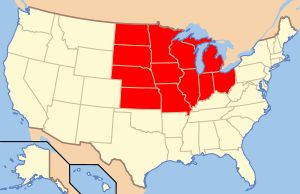
Sometimes called "the breadbasket of America" the Midwest serves as a center for grain production, particularly wheat, corn and soybeans.[3] Graham bread, steamed cornbread, and johnny cakes are traditional Midwestern foods, as are butter cakes like chocolate cake, devil's food cake, coconut cake and fruit cake. Flour was also used to make light sponge cakes, doughnuts, cookies, pastry, and quick breads like soda bread and baking powder biscuits. Cereals like oatmeal, cracked wheat and corn meal were used to make gruel or "mush" when prepared without milk.[4]
In 1839 the Northeastern state of New York became the country's leading dairy producer, a position it held until overtaken by Iowa in 1890. It wasn't long after that Wisconsin emerged as the leading dairy producer.[5]
Beef and pork processing have long been important Midwestern industries. Chicago and Kansas City served as stockyards and processing centers of the beef trade and Cincinnati, nicknamed 'Porkopolis', was once the largest pork-producing city in the world.[6] Iowa is the center of pork production in the U.S.[7] Meats were preserved by curing as in corned beef, sugar-cured ham and bacon, or smoked. Pork sausages were flavored with black pepper and sage and smoked to make frankfurters. To make breakfast sausages liver, heart and bread were added. Other types of sausage included liver sausage, blood sausage, bologna, cervelat and wiener wurst. Hamburg steak was made from tough cuts of beef with suet[4]
Ingredients commonly used in the Midwestern states include beef, pork, potatoes and corn. Apple pie is also popular though other local ingredients vary among states.[8] Potatoes are steamed, boiled or added to a potato chowder made with milk, butter and salt pork.[4] They also feature German potato salad and the potato dumplings commonly served in local pubs. The Upper Midwest has morel mushrooms, strawberries, blackcaps, gooseberries and blackberries.[9]
Early history
In the 19th century, as the frontier advanced westward, recipes had to be adapted based on the availability of ingredients. A traditional Midwestern breakfast in the 19th century might have included lamb chops, liver, bacon, pan-fried fish, oysters, eggs, potatoes, fruit compote or preserves, and hearty dough-based dishes like pie, doughnuts or cookies.[5] At harvest time families would have eaten mostly home produced foods. The table would be laden with fried chicken, pickles, relish, beets, cottage cheese, roast meats, potatoes, pork chops, fresh bread, fried green tomatoes, pies and biscuits.[10]
German and Swiss immigrants made dairy products including cheese, milk, butter, white sauces and homemade cottage cheese. They raised milk-fed veal and produced a type of white beer called weisse bier. Swedes, Norwegians and Finns began to settle the Midwest in the late 18th century, introducing rich, butter-laden cakes and cookies.[5]
At the turn of the century cruise ships operating along the Great Lakes offered varied dining selections. Seasonal fruits, oats, hash browns puffed rice, sirloin steak, and lamb kidney saute with mushrooms were some of the breakfast offerings available in 1913.[11] Beginning in the 1930s fine dining on railroads included cashew chicken, baked filet of Lake Superior white fish au Gratin and floating island dessert with custard sauce.[12] The expansion of railroads in the 1870s and 1880s allowed fresh citrus fruits to be shipped to the Midwest.[5]
Ethnic influence
As with many American regional cuisines, Midwestern cooking has been heavily influenced by immigrant groups. Throughout the northern Midwest, northern European immigrant groups predominated, so Swedish pancakes and Polish pierogi are common. Wisconsin, Missouri, Kansas, Ohio and Illinois were destinations for many ethnic German immigrants, so pork sausages and potatoes are prevalent. In the Rust Belt, many Greeks became restaurateurs, imparting a Mediterranean influence. Native American influences show up in the uses of corn and wild rice.[13]
German immigrants brought dishes like Hassenpfeffer, sauerbraten, Spätzle, Maultasche, Schnitzel and pumpernickel bread. Scandinavian dishes include pickled fish, smoked fish, and salted fish, lutefisk, dark breads, Danish frikadeller and aebleskivers served with chokecherry or blueberry syrup.[14]
A Wurst mart, sometimes spelled Wurstmart or Wurst Markt, is a variation on a fish fry found predominantly in German-American communities. Wurst marts are usually held by churches as fundraising events, where people will pay for a buffet of sausages and other side dishes. Common side dishes include mashed potatoes, gravy and sauerkraut. Wurst Mart comes from the German word "Wurstmarkt", meaning sausage market. Wurst marts are found mostly in small rural German-American communities in the Midwest, particularly around St. Louis.
Urban centers
Chicago
Following the Civil War, Chicago made use of railway networks to establish distribution networks, making fresh beef widely available. For the first time American consumers without access to local livestock could purchase fresh beef. The Chicago style hot dog is an all-beef frankfurter served in a poppy seed bun with mustard, white onion, relish, pickles, tomato wedges and celery salt.[15] Vienna Beef became a major producer of hot dogs and by the early 2000s was one of the major suppliers for hot dog carts.[5] Some other Chicago meatpackers are Armour, Oscar Meyer, Hygrade and Swift. Chicago meat packer Gustavus F. Swift is credited with commercializing shipping fresh meat in refrigerated railroad cars. By 1892 the number of refrigerated railroad cars in use exceeded 100,000.[5]
Jewish immigrants from eastern Europe ate a type of oatmeal cereal called krupnik that sometimes had barley, potatoes and fat added, and milk when it was available. Orthodox Jews continued to observe kashrut Sweatshop laborers carried bagels, knish and herring to work.[5] Chicago's Greektown serves traditional dishes like gyros and flambé cheese saganaki.[16] Steamed tamales made from cornmeal filled with seasoned ground beef have been available in Chicago since the 19th century.[15]
Thin-crust pizza arrived in Chicago with Italian immigrants in 1909. The origin of deep dish pizza is disputed but some say Pizzeria Uno first started serving the iconic dish in 1943.[17] When American forces returned from World War II with a taste for Italian foods pepper and onion topped Italian pork sausage sandwiches became widely available. They can still be found at festivals, fairs and ballparks today.[5] Italians are also known for Chicken Vesuvio, bone-in chicken sauteed with oregano and garlic in white wine sauce before and finished in the oven with potatoes.[15]
In 1903 James L. Kraft founded a wholesale cheese distribution business in Chicago which became Kraft Foods. Miracle Whip was introduced in 1933 at an industry event.[5] The American Licorice Company founded in Chicago in 1914 makes Red Vines and Super Ropes. Brach's company in Chicago started making candy corn in the 1920s. The Dove Bar was invented in Chicago.[5] Cracker Jack was founded by a German immigrant who in 1871 started selling molasses-coated, steam-popped corn out of a candy shop in Chicago's South Side.[15]
Chicago is known for its sandwiches like the Italian Beef sandwich which originated during the Great Depression. Starting with tougher cuts the beef is cooked slowly for several hours then sliced thin and served with sweet green pepper on a roll that's been softened in the beef's own juices. Chicago's Puerto Rican population have introduced the skirt steak sandwich Jibarito using fried green plantain instead of bread. Today this sandwich is made with chicken, roast pork, ham, shrimp and even the vegetarian option tofu is available.[15] Throughout the city there are many variations on classic sandwiches like the club sandwich served on bagels or other artisan breads like sourdough or brioche with complex spreads like aioli and piri piri sauce.[18]
Cincinnati
The Queen City is known for its namesake Cincinnati chili, a Greek-inspired meat sauce (ground beef seasoned with cinnamon, nutmeg, allspice, cloves, bay leaf, cumin, and ground chilis), served over spaghetti or hot dogs. Unlike chili con carne, Cincinnati-style chili is almost never eaten by itself and is instead consumed in "ways" or on cheese coneys, which are a regional variation on a chili dog.
Goetta, a meat-and-grain sausage or mush made from pork and oats, is unique to the Greater Cincinnati area and "every bit as much a Queen City icon"[19]:244 as Cincinnati chili. It is similar to the traditional porridge-like German peasant food stippgrutze but incorporates a higher proportion of meat-to-grain and is thicker, forming a sliceable loaf. Slices are typically fried like sausage patties and served for breakfast.[6] More than a million pounds of goetta are served in the Cincinnati area per year.[6]
The city has a strong German heritage and a variety of German-oriented restaurants and menu items can be found in the area. Cincinnati's Oktoberfest Zinzinnati, an annual food and music celebration held each September, is the second-largest in the world.[20] Taste of Cincinnati, the longest running culinary arts festival in the United States, is held each year on Memorial Day weekend. In 2014, local chefs and food writers organized the first annual Cincinnati Food & Wine Classic, which drew chefs and artisan food producers from the region.[21][22]
The area was once a national center for pork processing and is often nicknamed Porkopolis, with many references to that heritage in menu-item names and food-event names;[6] pigs are a "well-loved symbol of the city."[6]
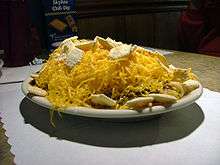
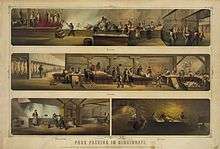 Pork packing in Cincinnati 1873
Pork packing in Cincinnati 1873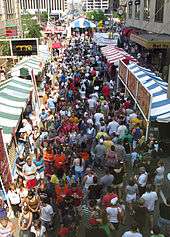 Taste of Cincinnati 2009
Taste of Cincinnati 2009
Cleveland
Cleveland's many immigrant groups and heavily blue-collar demographic have long played an important role in defining the area's cuisine. Ethnically, Italian foods as well as several Eastern European cuisines, particularly those of Poland and Hungary, have become gastronomical staples in the Greater Cleveland area. Prominent examples of these include cavatelli, rigatoni, pizza, Chicken paprikash, stuffed cabbage, pierogi, and kielbasa all of which are widely popular in and around the city.[23] Local specialties, such as the pork-based dish City Chicken and the Polish Boy (a loaded sausage sandwich native to Cleveland), are dishes definitive of a cuisine that is based on hearty, inexpensive fare. Commercially, Hector Boiardi (aka Chef Boyardee) started his business in Cleveland's Little Italy.[23]
Sweets specific to the Cleveland area include the coconut bar (similar in many respects to the Australian Lamington).[24] Coconut bars, which are found in many Jewish bakeries in the area, are small squares of cake that have been dipped in chocolate and rolled in coconut.[25] In Italian bakeries around the Cleveland area, a variation of the Cassata cake is widely popular. This local version is unlike those typically found elsewhere being that it is made with layers of sponge cake custard and strawberries, then frosted with whipped cream. In a celebrity-chef nod to this version, Mario Batali said that the Cassata cake at Corbo's Bakery in Little Italy was the best in the United States.[26]
Columbus
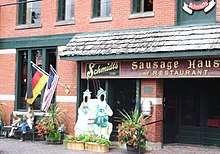
The Columbus, Ohio area is the home and birthplace of many well-known fast food chains, especially those known for hamburgers. Wendy's opened its first store in Columbus in 1969, and is now headquartered in nearby Dublin. America's oldest hamburger chain, White Castle, is based there. Besides burgers, Columbus is noted for the German Village, a neighborhood south of downtown where German cuisine such as sausages and kuchen are served. In recent years, local restaurants focused on organic, seasonal, and locally or regionally sourced food have become more prevalent, especially in the Short North area, between downtown and the Ohio State University campus. Numerous Somali restaurants are also found in the city, particularly around Cleveland Avenue.
Columbus is also the birthplace of the famed Marzetti Italian Restaurant, opened in 1896. Owner Teresa Marzetti is credited with creation of the beef-and-pasta casserole named after her brother-in-law, Johnny Marzetti. The restaurant's popular salad dressings became the foundation for the T. Marzetti Company, an international specialty foods manufacturer and distributor, headquartered in Columbus.
Detroit
Detroit specialties include Coney Island hot dogs, found at hundreds of unaffiliated "Coney Island" restaurants. Not to be confused with a chili dog, a coney is served with a ground beef sauce, chopped onions and mustard. The Coney Special has an additional ground beef topping. It is often served with French fries. Food writers Jane and Michael Stern call out Detroit as the only "place to start" in pinpointing "the top Coney Islands in the land."[19]:233
Detroit also has its own style of pizza, a thick-crusted, Sicilian cuisine-influenced, rectangular type called Detroit-style Pizza. Other Detroit foods include zip sauce, served on steaks; the triple-decker Dinty Moore sandwich, corned beef layered with lettuce, tomato and Russian dressing; and a Chinese-American dish called warr shu gai or almond boneless chicken.
The Detroit area has many large groups of immigrants. A large Arabic-speaking population reside in and around the suburb of Dearborn, home to many Lebanese storefronts. Detroit also has a substantial number of Greek restaurateurs. Thus, numerous Mediterranean restaurants dot the region and typical foods such as gyros, hummus and falafel can be found in many run-of-the-mill grocery stores and restaurants.
Polish food is also prominent in the region, including popular dishes such as pierogi, borscht, and pączki. Bakeries concentrated in the Polish enclave of Hamtramck, Michigan, within the city, are celebrated for their pączki, especially on Fat Tuesday. Hungarian food is featured in nearby eastern Toledo, Ohio with Tony Packo's Hungarian hot dog, a form of kolbász.
Chinese restaurants in the Detroit area serve Almond boneless chicken,[27] a regional Chinese-American dish consisting of battered fried boneless chicken breasts served sliced on a bed of lettuce with a gravy-like chicken flavored sauce and slivered almonds.[28]
In nearby Ann Arbor the Chipati, a tossed salad, is served inside a freshly baked pita pocket with the "secret" Chipati sauce on the side. The Chipati's origination is claimed by both Pizza Bob's on S. State St. and by Pizza House on Church St.
Kansas City
Kansas City is an important barbecue and meat-processing center with a distinctive barbecue style. The Kansas City metropolitan area has more than 100 barbecue restaurants[29] and proclaims itself to be the "world's barbecue capital." The Kansas City Barbeque Society spreads its influence across the nation through its barbecue-contest standards. The oldest continuously operating barbecue restaurant is Rosedale Barbecue near downtown Kansas City. Other popular barbecue restaurants are Gates Bar-B-Q, Joe’s Kansas City Bar-B-Que and Arthur Bryant's. Both Arthur Bryant's and Gates Bar-B-Q sell bottled versions of their barbecue sauces in restaurants and specialty stores in the surrounding areas.
Minneapolis and Saint Paul
Minneapolis used to be known as "Mill City" and homemade breads and pies feature prominently in Minnesota's cuisine.[30] Bread and cakes were available at the Eagle Bakery in 1850 included fruitcake, pound cake and "Fancy cake" for the holidays. In the 1930s there were four Jewish bakeries within a few blocks of each other baking bagels and other fresh breads. Jewish families purchased challah loaves for their Sabbath meal at the North Side Bakery. There were two kosher meat markets and four Jewish delicatessens, one of which began distribution for what would become Sara Lee frozen cheesecakes. The delis sold sandwiches like corned beef and salami.[31]
American restaurants in the Twin Cities supply a wide spectrum of choices and styles that range from small diners, sports bars and decades old supper clubs to high-end steakhouses and eateries that serve new American cuisine using locally grown ingredients. There are many restaurants serving various Polish dishes like polish sausage, pierogies and stuffed cabbage rolls.[32] and typical German foods like rippchen, knackwurst, and wienerschnitzel. Traditionally, potato salad and kraut were served alongside an entree of bratwurst or ham hocks. A side of spaetzle and red cabbage would accompany sauerbraten or rouladen.[33]
In the fall, the Twin Cities share along with Green Bay, Wisconsin, the tradition of the neighborhood booyah, a cuisine and cultural event featuring a hodge-podge of ingredients in stews. The Jucy Lucy (or "Juicy Lucy") is a hamburger with a core of melted cheese.[30] Barbecue restaurants in the area tend to feature a combination of the various regional styles of this type of cooking.
Asian cuisine was initially dominated by Chinese Cantonese immigrants that served Americanized offerings. In 1883 Woo Yee Sing and his younger brother, Woo Du Sing, opened the Canton Cafe in Minneapolis, the first Chinese restaurant in Minnesota.[34][35] Authentic offerings began at the influential Nankin Cafe which opened in 1919,[36] and many new Chinese immigrants soon took this cuisine throughout the Twin Cities and to the suburbs. The cuisine of Japan has been present since the opening of the area's very first Japanese restaurant, Fuji Ya in 1959.
Minneapolis and St. Paul also offer a diverse array of cuisines influenced by their many immigrant groups. In the 1970s the Twin Cities saw a large influx of Southeast Asian immigrants from Cambodia, Laos, Thailand and Vietnam. Since 1976 Supenn Supatanskinkasem has been cooking and serving Thai food through her Minnesota State Fair Booth, Siam Café, and Sawatdee chain of Thai restaurants.[37] Modern dining options include phở noodle shops, banh mi and Thai curry restaurants. Restaurants offering other cuisines of Asia including those from Afghanistan, India, Nepal and the Philippines are also fairly recent additions to the Twin Cities dining scene. Local ingredients are often integrated into Asian offerings, for example Chinese steamed walleye and Nepalese curried bison.
Mexican and Tex-Mex restaurants serve tacos, tortas, tamales and other similar dishes. Cuisines from Argentina, Brazil, Cuba, Ecuador, Peru and the Spanish Speaking West Indies are also represented, as well as Native American cuisine.[38][39]
The Twin Cities are home to many restaurants that serve the cuisines of the Mediterranean, Middle East and Northeast Africa including, Greek,[40] Ethiopian and Somalia have also opened a number of restaurants in Minnesota.[41] In addition, West African immigrants have introduced their own cuisine in recent years. There is also a presence of Afro-Caribbean restaurants, with the famed Nicollet Avenue in Minneapolis being home to two Caribbean restaurants.
Omaha
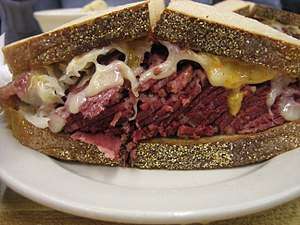
Omaha has some unusual steakhouses such as the famous Gorat's, several of which are Sicilian in origin or adjacent to the Omaha Stockyards. Central European and Southern influences can be seen in the local popularity of carp and South 24th Street contains a multitude of Mexican restaurants. North Omaha also has its own barbecue style.
Omaha is one of the places claiming to have invented the reuben sandwich, supposedly named for Reuben Kulakofsky, a grocer from the Dundee neighborhood.[42]
Godfather's Pizza is one of the chain restaurants that originated in Omaha.[43]
The cheese frenchee is also a local favorite and staple, originating from the original King's Food Host fast food restaurants.[44]
St. Louis
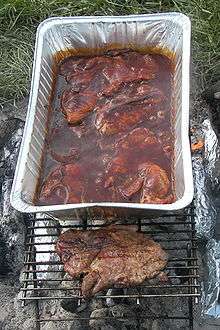
The large number of Irish and German immigrants who came to St. Louis beginning in the early nineteenth century contributed significantly to the shaping of local cuisine as confirmed by a variety of uses of beef, pork and chicken, often roasted or grilled, as well as a variety of desserts including rich cakes, stollens, fruit pies, doughnuts and cookies. Even a local form of fresh stick pretzel, called Gus's Pretzels, has been sold singly or by the bagful by street corner vendors.
Mayfair salad dressing was invented at a St. Louis hotel of the same name, and is richer than Caesar salad dressing. St. Louis is also known for popularizing the ice cream cone and for inventing gooey butter cake (a rich, soft-centered coffee cake) and frozen custard. Iced tea is also rumored to have been invented at the World's Fair, as well as the hot dog bun.
A staple of grilling in St. Louis is the pork steak, which is sliced from the shoulder of the pig and often basted with or simmered in barbecue sauce during cooking. Other popular grilled items include crispy snoots, cut from the cheeks and nostrils of the pig; bratwurst; and Italian sausage, often referred to as "sah-zittsa," a localization of its Italian name, salsiccia. Maull's is a popular brand of barbecue sauce in the St. Louis area.
Restaurants on The Hill reflect the lasting influence of the early twentieth century Milanese and Sicilian immigrant community. Two unique Italian-American style dishes include "toasted" ravioli, which is breaded and fried, and St. Louis-style pizza, which has a crisp, thin crust and is usually made with Provel cheese instead of traditional mozzarella cheese.
A Poor boy sandwich is the traditional name in St. Louis for a submarine sandwich. A St. Paul sandwich is a St. Louis sandwich, available in Chinese-American restaurants. A Slinger is a diner and late night specialty consisting of eggs, hash browns and hamburger, topped with chili, cheese and onion.
Regional specialties
Illinois
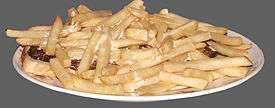
Early settlement in Illinois along the Ohio River included farm owners, tenant farmers and sharecroppers. The lowest rung were called "river rats", similar to folks who lived along the Illinois River foraging for clams and mussels, mostly German, Irish, English and Appalachian. By 1890, fish from the Illinois river were being sent upstream to Chicago for sale in commercial markets on the east coast. Carp and buffalo fish were used to make gefilte fish or fried carp in cornmeal batter. During winter months when fish, clams and mussels were inaccessible the "river people", or alternately "shantyboat dwellers" hunted possums, beaver or raccoons.[45]
Beans, pork, and potatoes were dietary staples in Southern Illinois. Fried eggs, fried pork, biscuits, fruit preserves and coffee were traditional breakfast foods. Dinner options consisted of boiled or fried potatoes, green beans cooked in fat, boiled pork, fried fat pork, sliced tomatoes, lettuce wilted with vinegar, macaroni with tomatoes, pie and cake. Whole milk was usually not available outside wealthy families but children were sometimes given skimmed milk. Lower-income families consumed less milk, meat and eggs.[46] German settlers arriving in the 19th century brought foods like wienerschnitzel, sauerbraten, potato pancakes, rouladen, bratwurst, liverwurst. hasenpfeffer, liver dumplings, cakes like Black Forest cake, Lebkuchen and Schnecken, strudel and cookie recipes like Sandbakelse and Pfeffernüsse.[5][45]
The horseshoe sandwich is rarely seen outside Springfield, Illinois where it originated. The original version was an open-faced sandwich made a horseshoe-shaped ham steak and two pieces of white toast but it is available with other types of meat also like chicken cutlets or hamburger. The sandwich is served with a cheese sauce similar to Welsh rarebit and french fries.[47]
Indiana
Indiana claims shoreline along Lake Michigan so freshwater fish like perch and walleye have a place on local menus. Biscuits and gravy, topped with sausage gravy, can be found at diners throughout the state, sometimes served with eggs on the side, or other breakfast sides like home fries. Chicken and noodles (or beef and noodles) are served over mashed potatoes. German pubs serve traditional fare like sausages, schnitzels, rouladen, and sauerbraten. Fried brain sandwich is not very common any more but was more widely available in the past. It was first brought to Evansville by German immigrants.[48]
Fried biscuits are a specialty of the state, served with cinnamon sugar and spiced apple butter. Deep-fried pork tenderloin and fried bologna sandwiches are popular in Indianapolis and other parts of the state.[48] Fried chicken is a staple of after-church dinner on Sundays (Indiana's version uses more black pepper than most).[49] A popular dish seen almost exclusively in Indiana is sugar cream pie (also called Hoosier pie) which most likely originated in the state's Amish community. Some say it originated with the Shaker settlements along Indiana's eastern border with Ohio. Sometimes called "desperation pie", the simple milk and sugar pie may be related to the Amish Bob Andy pie, Pennsylvania's shoo-fly pie and North Carolina's brown sugar pie.[50][48] Persimmon pudding made with sweet, wild persimmons is a typical Thanksgiving dish in Indiana.[51]
Indiana produces more popcorn than any other state except Nebraska.[48]
Iowa
When French Icarians arrived in the 19th century their simple meals were put together using just a few basics: milk, butter, bacon and corn bread. The Amana Colony settled on the rich soils of Iowa and until the 1930s their meals were provided by communal kitchens supplied by the village orchards, communal gardens, vineyards, bakery, smokehouse and dairy. Iowa's last communal meal was served in 1932. Traditional recipes from Amana's communal kitchens include radish salad, apple bread, strawberry rhubarb pie, and dumpling soup.[52]
Danish immigrants brought apple cake and spherical æbleskiver pancakes. Dutch letters, pastries filled with almond paste and shaped like an 'S,' are also common in Iowa, although they were historically only made for Sinterklaas Day. Iowa's Dutch bakeries offer other baked goods like speculaas and boter koek. Czech immigrants contributed pastry filled with sweetened fruit or cheese called kolaches. Kringla, krumkake and lefse are found at church suppers throughout the holiday season when a typical lutefisk dinner would include mashed potatoes, cranberry salad, corn, rutabaga, rommegrot, meatballs with gravy, and Norwegian pastry for dessert.[52][52]
Recipes compiled and published by the Des Moines Register include salmon mousse, fresh gazpacho, apple coleslaw, cabbage n' macaroni slaw, other slaws, soups, and dips, and various salads like turkey-melon, shrimp-yogurt and pasta-blackbean, including one gelatin-based salad made with 7Up, lemon-lime gelatin, crushed pineapple, marshmallow and bananas. Other gelatin based salads included blueberry salad and a "Good Salad" which included a mix of puddings, orange gelatin and citrus fruits.[53]
Basic soups included cauliflower-cheddar garnished with scallions, cream of carrot made with milk and rice, and beef noodle soup made with frozen vegetables and beef bouillon. Various beverage offerings included cool apple-mint tea, a citrus mix that included orange juice, lemonade powder and club soda, as well as coffee flavored with cinnamon.[53]
The state is the center for loose-meat sandwiches, also called tavern sandwiches and appearing on many menus by each restaurant's unique name for them.[19]:266 They originated in the region in the Ye Olde Tavern restaurant in 1934 before being popularized by Maid-Rite in 1936, which now has franchises in other Midwestern states.[54] The original Maid Rite sandwich from the 1920s is a ground meat sandwich with pickles, ketchup, mustard, and onions. Hot beef sandwich is made with leftover pot roast topped with gravy and mashed potatoes.[55]
Iowa is the leading pork producer in the United States.[56] This is reflected in Iowan cuisine, which includes the pork tenderloin sandwich (or simply 'pork tenderloin'), consisting of a lean section of boneless pork loin that is pounded flat, breaded, and deep fried before being served on a seeded hamburger bun with any or all of ketchup, mustard, mayonnaise, and dill pickle slices. It is a popular "fair food" at the Iowa State Fair where the meat where the meat of a pork tenderloin sandwich is often far larger than the area of the bun. Burgers are made with local beef.[55]
Iowa is the leader in corn production in the United States, also leading in production of eggs and pork.[52] One well-known variety of sweet corn grown in Iowa is the bi-color peaches and cream.[55] Rhubarb grows well in Iowa and is used for sauces, jams, cakes and pies. Heirloom varieties like Green Moldovan tomatoes, St. Valery carrot and Cimarron lettuce are still grown at the Plum Grove Historic Site. Locally brewed beers like pale ale and lager varieties are made with wheat and barley.[52]
Kansas
Potluck suppers, farmhouse meals and after-church Sunday dinners are part of the food culture of Kansas. Smoked brisket, pork shoulder, short ribs, hot wings are served with sides like macaroni and cheese, mashed potatoes, string beans, jalapeno poppers and cheesy potatoes and some places still offer whole hog barbecue.[57][58] Kansas is a cattle producing state so pot roasts and steak dinners are staples of the local diet.[59]
Classic comfort foods like fried chicken and chicken fried steak are standard diner fare.[59] Chili is served alongside cinnamon rolls in a commonly found but unlikely pairing.[59] Breakfast burritos are filled with scrambled eggs and fillings like potatoes, salsa, cheese and tomatillos. Other offerings include pastor, carnitas, carne asada, pork rind and tinga.[60]
Pies include cherry pie, coconut meringue and coconut cream pie. Bierock is a stuffed yeast bread filled with sausage, ground beef, cabbage and onion that was introduced by Volga Germans.[59] It was a hearty, portable lunch for field laborers.[61] Today, it can be found in varieties like garlic chicken or vegetable.[59] Similarly, the Czech pastry kolaches are yeast buns available with a range of fruit and cheese based fillings like prune, apricot, cottage cheese, cherry, apple, peach and poppy seed.[61] Cake doughnuts like pumpkin spice, maple, and caramel apple are produced seasonally.[62]
Alcoholic beverages
As of November 2006, Kansas still has 29 dry counties and only 17 counties have passed liquor-by-the-drink without a food sales requirement.[63] Today there are more than 2600 liquor and 4000 cereal malt beverage licensees in the state.[64]
Michigan
Michigan is a large producer of asparagus, a vegetable crop widespread in Spring. Western and northern Michigan are notable in the production of apples, blueberries, and cherries. The Northwestern region of Michigan's Lower Peninsula accounts for approximately 75 percent of the U.S. crop of tart cherries, usually about 250 million pounds (11.3 Gg).[65] A popular dish, Michigan Chicken Salad, includes cherries and often apples. Fruit salsas are also popular with cherry salsa being especially prominent. Michigan's wine and beer industries are substantial in the region. The Traverse City area is a popular destination to visit wineries and the state makes many varieties of wine, such as Rieslings, ice wines, and fruit wines. Micro-breweries continue to blossom creating a wide range of unique beers. Grand Rapids was voted Beer City USA 2013 in the Beer City USA poll, with Founders being the largest of Grand Rapids' breweries. Bell's, another large Michigan craft brewery is located further south in Kalamazoo.
Michigan is the home of both Post and Kellogg, with Battle Creek being called Cereal City. Vernor's ginger ale and Faygo pop also originate in Michigan. Vernor's ginger ale is often used as a home remedy for an upset stomach.
Coney Islands, a type of diner originating with Greek immigrants in Detroit, are fairly common throughout the state.[19]:233 A Coney is many times a natural casing hot dog on a bun, topped with raw onion, mustard, and Coney sauce, a type of chili. Cheese may be added as well and variations are found throughout the state, with each city claiming theirs is the best. These diners usually also have gyros served with cucumber or honey mustard sauce, as well as hamburgers, sandwiches, breakfast and dinner entrees. Most Coney Islands are open 24 hours and also a popular place to get a late or early coffee.
In Polish communities throughout the state Pączki can be found every year on Fat Tuesday (Mardi Gras) in a wide assortment of flavors including lemon, blueberry to custard. Pierogis, goulash, and Polish style sausage are common specialties in many restaurants.
Fish fries are common on Fridays and during Lent. Fish fries are usually set up buffet style typically consisting of items including rolls, potatoes (typically in the form of french fries and mashed), salad, coleslaw, apple sauce, deep fried fish and sometimes fried shrimp and baked fish. Fish is generally popular throughout the state due to the state's location on four of the Great Lakes. Trout, walleye, perch and catfish are common. Whitefish is a regional specialty usually offered along the coast, with smoked whitefish and whitefish dip being noteworthy.
Cornish immigrant miners introduced the pasty to Michigan's Upper Peninsula (U.P.) as a convenient meal to take to work in the numerous copper, silver, and nickel mines of that region.[19]:270 The pasty is today considered iconic of the U.P.
Fudge is commonly sold in tourist areas, with Mackinac Island being most famous for its fudge, traditionally chocolate, but there is a wide variety of flavors from mint to maple and may include nuts, fruit, or other candy pieces.
Minnesota
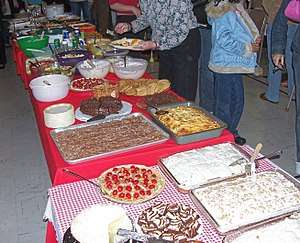
Letters and household accounts of Minnesota residents give details of mid-19th century frontier cuisine. A farmer's wife writes to her cousin about harvest in Rochester, Minnesota "My hand is so tired perhaps you'll excuse penciling", explaining she woke before four to skim milk, churn butter and bake "6 loaves of bread & seven pumpkin pies". In the 1850s supplies couldn't keep pace with settlement, though steamboats regularly brought in sugar-cured hams, oysters, herring, sardines, alcohol, salt pork and other supplies.[66]
In those days a full multi-course meal served for a special occasions might begin with a soup like mock turtle or calf's head, followed by a choice of local fish and the so-called "boiled dishes" like chicken with egg sauce, ham or corned beef. Entrees like blanquette of veal with capers, breaded veal cutlets with fried potatoes, fricasse chicken with oysters were followed by assorted roast meats served with cranberry sauce.[66] A fancy Victorian-style luncheon may have included dishes like shirred eggs, chicken à la King, peach melba and bath buns.[67] Pastries served at an upscale event in 1857 included nine types of pie: cranberry, peach, green apple, pumpkin, lemon, grape, plum, mince and raisin. Other desserts included ladyfingers, sponge cake, macaroons, brandy jellies, blancmange, jelly puffs and wafer jumbles.[66]
In northern Minnesota, along the North Shore of Lake Superior, commercial fishing has been practiced for generations.[68] Settlers were used to the cold, rugged work as many of these immigrants came directly from the coastal fishing villages of Norway.[69][68] Ciscoes (also known as lake herring), lake trout, lake whitefish, and rainbow smelt are still commercially fished today.[68] Smoked or sugar-cured trout is prepared from local fish in areas along the North Shore like Duluth.[70][71][72] Walleye is the state fish of Minnesota and it is common to find it on restaurant menus. Battered and deep-fried is a popular preparation for walleye, as is grilling. Many restaurants feature walleye on their Friday night fish fry.
Walleye, trout, herring, crappie, lutefisk, wild rice, raspberry, blueberry and strawberry are preferred ingredients in Minnesotan cuisine. Typical sides include mashed potatoes, pickles, jello salad, locally grown boiled new potatoes seasoned with fresh herbs or horseradish, baked beans, and vegetables like sweet corn on the cob, or buttered peas, carrots and green beans. Preferred to rice or pasta, potatoes are often served alongside buttered rolls and homemade strawberry jam.[8]
Scandinavian cuisine has had a significant impact on the cuisine of Minnesota. Among the state's most iconic dishes are lefse and lutefisk, brought to the state by Scandinavian immigrants. Lefse is a Norwegian flatbread made from flour, potatoes, cream and butter, and in Minnesota it is commonly prepared for Christmas dinner.[30] Lutefisk is a traditional dish of the Nordic countries made from stockfish (air-dried whitefish) and soda lye (lut). Scandinavian rice pudding is also served during the holidays.[8] The cafe at the American Swedish Institute serves Swedish dishes like gravlax with dill, potato dumplings and Swedish meatballs with lingonberry jam.[30]
Arriving in the 19th century, immigrants from Eastern Europe opened delicatessens, bakeries and restaurants, and introduced dishes like varenyky, krakowski, poppy seed roll, kluski, kolaches and stuffed cabbage rolls to the Midwest.[30][73][74] German immigrants brought kohlrabi with them.[75]
Minnesota is known for its church potlucks, where hotdish is often served. Hotdish is any of a variety of casserole dishes, which are popular throughout the United States, although the term "hotdish" is used mainly in Minnesota, Wisconsin, North Dakota, and South Dakota. Hotdishes are filling comfort foods that are convenient and easy to make. "Tater Tot Hotdish" is a popular dish, and as Minnesota is one of the leading producers of wild rice, wild rice hotdishes are quite popular.[76] Minnesota goulash, a combination of tomatoes, macaroni, ground beef and creamed corn is popular as well. Dessert bars are the second of the two essentials for potlucks in Minnesota.[77] Other regional dishes include scalded hoecakes, milk hoecakes, cinnamon toast, hominy pudding, glorified rice, baked stuffed apples and corn chowder.[78]
The Iron Range region in Upper Minnesota is known for Cornish pasties, a meat and vegetable filled pastry that was brought to Minnesota by mine workers. The pasties were an easy lunch for those working deep in the iron mines though the local variations diverged from the original Cornish recipe.[79][80] Slovenian and Croatian immigrants brought the honey-nut bread called potica to the Iron Range region. Served during the Easter and Christmas seasons, potica is still very popular in northern Minnesota.[81] Porketta, a pork roast seasoned with fennel and garlic and served with either sliced or shredded like a pulled pork sandwich was brought to Minnesota and the Iron Range region by Italian immigrants.[30][82][83][80]
The state is a productive area for chicken, dairy and turkey farms and crops such as corn, soybeans, and sugar beets and as such, eggs and meat along with potatoes and vegetables are mainstay foods. Recipes using local wild game such as bison, deer, elk[84] or moose[85] are also common. Elk and moose are both very lean meats that are high in protein. With their very low fat content they are generally marinated and roasted or slow-cooked to prevent the meat from becoming too dry and to improve texture.[86][87][88][89]
Several apple varieties including the Honeycrisp apple, Zestars, Haralson, Snowsweet, Frostbite and SweeTango were developed in Minnesota with contributions from the University of Minnesota.[90] The Mesabi cherry is a Minnesota-bred cross between sweet Bing cherries and tart cherries.[91][92]
Food selections served at the annual Minnesota State Fair could include watermelon pickles, baked beans, hot dogs, buffalo burgers, deep-fried cheese curds, glazed ham and homemade apple pie.[93] New foods for 2019 included fried tacos on a stick, Turkish pizza, stuffed cabbage rolls, feta bites, shrimp and grits fritters, blueberry key lime pie and assorted other dessert selections.[94]
Missouri
In Missouri, much of the cuisine is influenced by the various regions of the state. the Ozarks you will find that Country Ham, Fried Chicken, Catfish, and Frog Legs are popular entree choices served with fried potatoes, baked beans and biscuits. Mid-Missouri and Northern Missourians eat a lot of Beef (Steaks, Hamburgers, Meatloaf, and Roasts) and Pork (Steak, Roasts, Chops, and BBQ) sides often include some sort of Potato (Baked, Mashed, Cheesy, Fried) and Green (Green Beans, Asparagus, and Zucchini) are a few popular choices. Barbecue, mainly pork and beef, is popular in both St. Louis and Kansas City, as well as in much of the southern half of the state. In Southern Missouri, sweet tea is commonly available at restaurants; while in Northern Missouri most citizens prefer unsweetened tea. Missourians also love their beer and bacon with many businesses that specialize in production of those Missouri staples. St. Louis features, toasted ravioli, St. Louis-style pizza, and gooey butter cake. Kansas City is known for their K.C. Style Sauced Burnt Ends. Another region is the "Missouri Rhineland" along the valley of the Missouri River is known for its wineries. Missourians love their regional wines and often eat summer sausage, cheese, and crackers while enjoying.
Fishing is a popular sport throughout the state, and "Fish Fry(s)" are popular social events. Fish Fry(s) often feature catfish, large-mouthed bass, and/or Crappie (popular Missouri fishes). Fried potatoes, morel mushrooms (when in season), and onion rings are commonly fried as well at these social gatherings.
For Breakfast Missourians love their bacon, country ham, and breakfast sausage as their breakfast meats served with eggs, hash browns, and toast or biscuits. Biscuits and Gravy, Pancakes, and Breakfast Casseroles are also some favorites. [95]
Nebraska
A significant population of Germans from Russia settled in Nebraska, leading to one of the state's most iconic dishes, the Runza sandwich. Large numbers of Czech immigrants, particularly to southeastern Nebraska, influenced the culture and cuisine of the area.[96] Wilber, Nebraska is the self-designated "Czech Capital of the U.S.A." and celebrates an annual "Czech Days" festival at which Czech food, such as kolaches, roast duck, and pork and dumplings, is served.[97][98] In 2015, Nebraska resettled the largest number of refugees per capita in the United States and Lincoln, Nebraska has been a significant resettlement location for refugees since the 1980s, particularly Vietnamese-Americans.[99] A large Vietnamese-American population in Lincoln has created Vietnamese markets—which sell ingredients, such as fresh persimmon, not typically found in Midwestern grocery store chains—and Vietnamese restaurants which sell cuisine such as pho and Bánh mì.[99]
Nebraska is also known as the "Cornhusker State" in reference to the abundance of corn grown in the state. Corn is a common fixture of late-summer and autumnal meals in Nebraska in dishes such as corn souffle, corn chowder, cornbread, and corn on the cob. Early pioneers relied heavily on corn and cornmeal in everything from breads, (cornbread, corn mush rolls); to soups, (corn soup, Indian meal mush); and desserts, (green corn pudding, popcorn pudding, sweet corn cake).[100]
North Dakota
Cuisine in North Dakota has been heavily influenced by both Norwegians and Germans from Russia, ethnic groups which have historically accounted for a large portion of North Dakota's population. Norwegian influences in the state include lefse, lutefisk, krumkake, and rosettes. Much of the Norwegian-influenced cuisine is also common in Minnesota and other states where Norwegians and their descendants live(d), although Norwegian influence may be the greater in North Dakota than any other state, as Norwegians played a large role in settling the area, and nearly one-third of North Dakotans claim Norwegian ancestry. Norwegian ancestry was historically more widespread throughout the northern half and eastern third of North Dakota, and therefore plays a stronger role in local cuisine in those parts of the state.
German-Russian cuisine is primarily influenced by that of the Schwarzmeerdeutsche, or Black Sea Germans, that heavily populated south-central and southwestern North Dakota (an area known as the German-Russian Triangle), as well as areas of South Dakota. While large numbers of Wolgadeutsche, Germans from Russia who lived near the Volga River in Russia (several hundred miles away from the Black Sea), also settled in the United States, they did not settle in large numbers in the Dakotas. Popular German-Russian cuisine includes kuchen, a thin, cheesecake-like custard pastry often filled with fruit such as cherries, apricot, prunes, and sometimes cottage cheese. Fleischkuekle (or fleischkuechle) is a popular meat-filled thin flatbread that is deep-fried and served hot. Another German-Russian specialty in the area is knoephla, a dumpling soup that almost always includes potatoes, and to a lesser extent, celery.
Ohio
Buckeye candy is a confection popular in the state of Ohio is the local variation of a peanut butter cup known as a 'Buckeye'. Coated in chocolate, with a partially exposed center of peanut butter fudge, in appearance the candy resembles the chestnut that grows on the state tree, commonly known as the Buckeye.
Cincinnati-style chili is a Greek-inspired meat sauce, (ground beef seasoned with cinnamon, nutmeg, allspice, cloves, bay leaf, cumin, chili powder, and in some home recipes, chocolate), used as a topping for spaghetti or hot dogs. Additionally, red beans, chopped onions, and shredded cheese are offered as extra toppings referred to as "ways."
A popular snack food in Ohio are Sauerkraut Balls, a meatball-sized fritter containing sauerkraut and some combination of ham, bacon, and pork. The recipe was invented in the late 1950s by two brothers, Max and Roman Gruber for their five star restaurant, Gruber's, located in Shaker Heights, Ohio. These were a derivative of the various ethnic cultures of Northeast Ohio, which includes Akron and Greater Cleveland. An annual Sauerkraut Festival is held in Waynesville, Ohio.[19]:279 at which sauerkraut balls, along with other sauerkraut specialities, are served.
Clam bakes are very popular in Northeast Ohio. The region, which was originally part of the Connecticut Western Reserve, was initially settled by people from Connecticut and other New England states. A typical Northeast Ohio clam bake typically includes clams, chicken, sweet potatoes, corn, and other side dishes. Unlike in New England, seaweed is not used and the clams, chicken, and sweet potatoes are all steamed together in a large pot.[101]
Barberton, Ohio, part of the greater Akron area, is a small industrial city and home of Barberton Chicken, a dish of chicken deep fried in lard that was created by Serbian immigrants. It is usually accompanied by a hot rice dish, vinegar coleslaw and french fries.
Wisconsin
Wisconsin is "America's Dairyland," and is home to numerous frozen custard stands, particularly around Milwaukee and along the Lake Michigan corridor. The state also has a special relationship with Blue Moon ice cream, being one of the only places the flavor can be found. While the flavor's origins are not well documented, it was most likely developed by flavor chemist Bill "Doc" Sidon of Milwaukee, Wisconsin. The state is also well known as a home to many cheesemakers.
Arguably the most universal Wisconsin dessert would be the cream puff, a type of profiterole that is a famous treat at the Wisconsin State Fair. The southeastern Wisconsin city of Racine is known for its Danish kringle, a sweet flaky pastry often served as a dessert.
The Friday night fish fry, often battered and fried perch or walleye, is traditional throughout Wisconsin, while in northeast Wisconsin along Lake Michigan, the Door County fish boil holds sway.
Besides its "Cheesehead" status, Wisconsin has a reputation for alcohol consumption. Common traits of "drinking culture" are embedded in Wisconsin traditions, from festivals and holidays to everyday life. Many large breweries were founded in Wisconsin, largely in Milwaukee, which gained the epithet "Brew City" before the turn of the century: Miller, Pabst, Schlitz (all from and originally based in Milwaukee) and Leinenkugel all began as local favorites before entering the national and international markets.
"Booyah" is another very common and hearty Wisconsin meal, found especially in the Northeast region of the state. The origins of this dish are disputed, but the Wisconsin origin contends that the word is a vernacular Flemish or Walloon Belgian spelling of the French word bouillon, in this context meaning "broth."
Wisconsin cuisine also features a large amount of sausage, or wurst (German for "sausage"). The state is also a major producer and consumer of summer sausage, as well as the nation's top producer and consumer of brats.
Restaurants and pubs
Dark ales have been consumed in America since colonial times, while light-colored German lager was a mid-19th century arrival. The beer hall did not become established in the United States until the arrival of German immigrants in the mid-19th century. Taverns were generally seen as dark places with an exclusively male clientele. The beer hall, on the other hand, was in German culture views as a place where working-class families drank and ate together in groups at large tables. It was well lit and served traditional fare like sausages, sauerbraten, rollmops, sauerkraut and pickled herring. Beer halls continued in the Midwest after Prohibition.[102]
The popularity of Midwestern fast food like the iconic pizza and burgers started as a rejection of the drive-in model. "Car hops" where customers would be served while still in their cars was replaced by the franchise model. Cities like New York did not want fast food to compete with local establishments but the expansion of suburbs in the 1950s allowed fast food franchises to grow into these areas that lacked restaurants. Major Midwestern fast food franchises include McDonald's, Wendy's, Domino's and Pizza Hut. The growth of these franchises was bolstered by the development of interstate roads through the Midwest.[103]
The origin of "fast food" is uncertain, but one possibility is a hamburger stand that founded by Walter Anderson in Wichita, Kansas. Known today as White Castle, the fast food chain began to spread throughout the Midwest, offering a simple menu with hamburgers, Coca-Cola and coffee. By the 1920s White Castle had become a nationally-recognized chain, and until the 1940s White Castle style architecture was standard for fast food hamburger outlets throughout the United States.[102] McDonald's was originally founded in California in 1940, but purchased by Ray Kroc and moved to Des Plaines, Illinois in 1955.[104] Other burger chains include Winstead's, Max & Erma's and Schoop's Hamburgers.[105]
Several restaurant chains have roots in the Minneapolis-St.Paul area including Famous Dave's,[106] the defunct Chi-Chi's and Buca di Beppo, which was started out of a small Minneapolis basement in 1993.[107]
Portillo's Restaurants is another Midwestern fast food chain known for its hot dogs.[108] Lion's Choice is best known for its roast beef sandwiches. The chain is based mostly in Missouri, with locations in Kansas and Illinois. Wisconsin chain Culver's is known for its frozen custard and root beer.[109] Culver's has been recognized for their use of local dairy products like cheese and butter.[110] Happy Joe's is known for its taco pizza and has restaurants in several Midwestern states. Other notable chains include Harold's Chicken Shack, Skyline Chili, Spangles, Big John Steak & Onion, Graeter's, Maid-Rite and Cousins Subs.[111][105]
Pizzerias serving deep dish pizza include Gino's East, Giordano's Pizzeria and Buddy's Pizza, though the latter only has stores in Michigan.[111] Papa John's started by selling pizzas out of a Jeffersonville, Indiana pub.[112]
Dishes
These dishes, while not all exclusive to the Midwest, are typical of Midwestern foods. Although many foods are shared with other U.S. regions, they often feature uniquely Midwestern preparation styles.
- 7 layer dip
- barbecue
- beans
- beef, especially steak, pot roast and prime rib
- bread-and-butter pickles
- beer
- beer cheese soup
- brain sandwiches
- brandy
- bratwurst
- Buckeyes
- cabbage
- cabbage roll, also known as stuffed cabbage
- cheese, including cheese curds
- Chicken Vesuvio
- Chicken paprikash
- chislic
- cole slaw
- Coney Island hot dog
- Deep-fried bacon
- diner fare
- Door County fish boil
- doughnuts
- Duck
- freshwater fish, including catfish, perch, trout, walleye and whitefish and other panfish, often breaded and fried
- fried chicken
- frog legs
- frozen custard
- fruit, especially apples, blueberries, cherries, cranberries, peaches and strawberries
- fruit wines
- fruit pies
- German potato salad
- goulash
- hamburgers
- head cheese
- horseshoe sandwich
- hotdish or casseroles
- ice cream cone
- Italian beef
- gyro (loaf-style)
- Jello salads
- Johnny Marzetti
- lefse
- lutefisk
- maple syrup
- meatloaf
- morels
- pancakes
- pasties
- pea salad
- persimmon pudding
- pierogi
- pizza, with several regional styles
- pork
- potatoes, including mashed potatoes, potato pancakes, and potato salads
- ranch dressing
- ramps
- roast beef
- sauerbraten
- sauerkraut
- sausage, including bratwurst, kielbasa, summer sausage, ring bologna, and other ethnic types, as well as hot dogs, with several regional styles
- shrimp DeJonghe
- steak
- stollen
- sugar cream pie
- sweet corn, on the cob, in creamed corn and in corn relish
- turkey
- wild rice
References
- Crook, Nathan C. "Foods That Matter: Constructing Place and Community at Food Festivals in Northwest Ohio." Archived 2012-03-31 at the Wayback Machine (abstract). The Ohio Library and Information Network. Accessed July 2011.
- "Michigan/Great Lakes Region." Archived 2011-09-28 at the Wayback Machine Community Based Food and Farming. Archived 2011-07-20 at the Wayback Machine Sustainable Agriculture and Food Systems at Michigan State University Archived 2011-07-20 at the Wayback Machine. Accessed July 2011.
- "Cuisine_of_the_Midwestern_United_States". Docstoc.com. Retrieved 16 July 2015.
- "Minnesota Farmers' Library: Agricultural Extension Bulletin". University of Minnesota, Department of Agriculture, Extension Division. November 27, 1910 – via Google Books.
- The Oxford Companion of American Food and Drink
- Gray, Liz. "Porkopolis: Cincinnati's Pork-Producing Past". Great American Country. Retrieved 16 July 2015.
- U.S. Department of Agriculture (April 2020). Livestock Slaughter 2019 Summary (PDF) (Report). U.S. Department of Agriculture. p. 44-45. Retrieved 20 June 2020.
- Shortridge, Barbara G. (2003). "Not Just Jello and Hot Dishes: Representative Foods of Minnesota". Journal of Cultural Geography. 21: 71–94. doi:10.1080/08873630309478267.
- Motoviloff, John G. (2014). Wild Rice Goose and Other Dishes of the Upper Midwest. University of Wisconsin Press.
- Brookins, Jean A. (1975). "Book Review: American Food: The Gastronomic Story by Evan Jones". Minnesota History. 44 (7): 271–272. JSTOR 20178377.
- Minnesota Vacation Days: An Illustrated History, p34
- Minnesota Vacation Days: An Illustrated History, p47
- "United States Midwest Region Cuisine". My Meals are on Wheels. December 2011. Retrieved 16 July 2015.
- Kittler, Pamela Goyan (January 2016). Food and Culture. Cengage Learning. ISBN 9781305886872.
- Bizzari, Amy (2016). Iconic Chicago Dishes, Drinks and Desserts. Arcadia. ISBN 9781467135511.
- Clark, David G (2007). Route 66 in Chicago. Arcadia. p. 105. ISBN 9780738551388.
- Schnitzler, Nicole. "Deep dish: 107 years of Chicago pizza history". chicagotribune.com.
- "31 days of Chicago's best sandwiches". chicagotribune.com.
- Stern, Jane and Michael (2009). 500 Things to Eat Before it's Too Late: and the Very Best Places to Eat Them. New York: Houghton Mifflin Harcourt. ISBN 978-0-547-05907-5.
- "History of Oktoberfest". Oktoberfest Zinzinnati. Archived from the original on 17 July 2015. Retrieved 16 July 2015.
- Niesen Gosdin, Julie. "Cincinnati Food + Wine Classic reveals talent lineup of restaurant stars". WCPO. Archived from the original on 21 July 2015. Retrieved 18 July 2015.
- Campbell, Polly. "Cincinnati Food & Wine Classic crowds exceed expectations". Cincinnati Enquirer. Retrieved 18 July 2015.
- DeMarco, Laura (July 31, 2008). "Cleveland's best, as seen through the eyes of the rest of America". The Plain Dealer. Retrieved July 31, 2008.
- "Lamingtons or Coconut Bars?". playinwithmyfood.com. Retrieved 16 July 2015.
- "Family of Food: The Bar of Cleveland". familyoffood.blogspot.com. 2011-09-10. Retrieved 16 July 2015.
- "Corbo's Bakery moves west with a second location at Mapleside Farm". cleveland.com. 2012-10-07. Retrieved 16 July 2015.
- "Almond Boneless Chicken". Detroit Free Press. Retrieved 26 July 2015.
- "The Mystery of Almond Boneless Chicken - Chinese - Michigan - Tina Caputo". Zester Daily. Archived from the original on 2015-07-17. Retrieved 26 July 2015.
- Smith, Joyce (June 6, 2017). "The A-Z list of Kansas City-area barbecue restaurants, food trucks". Kansas City Star. Retrieved 2018-10-17.
- "What to Nosh in the North Star State: Minnesota's Most-Iconic Dishes". Food Com.
- Lewin, Rhonda. Jewish Community of North Minneapolis.
- "Best Polish Food In Minnesota". July 3, 2013.
- Minnesota Eats Out An Illustrated History, 93
- "Chinese American Experience In Minnesota". Archived from the original on January 8, 2013.
- Holmquist, June D. (1981). They Chose Minnesota: A Survey Of The States Ethnic Groups. Minnesota Historical Society Press. ISBN 9780873512312.
- "Chinese American Experience In Minnesota". Archived from the original on January 8, 2013.
- "Catching Up with Sawatdee's Supenn Harrison". Twin Cities Daily Planet. 21 February 2011. Retrieved 16 July 2015.
- Dean, Lee Svitak (October 7, 2017). "' 'Sioux Chef' serves up indigenous foods: 'It's what paleo wants to be' .. Sean Sherman explores diversity, hyperlocal foods and more in "The Sioux Chef's Indigenous Kitchen"". Star Tribune. Retrieved January 6, 2018.
- LeMay, Konnie (November 26, 2013). "Poet Heid Erdrich Turns Talents to a Cultural Cookbook Celebrating Indigenous Foods". Indian Country Today. Retrieved January 5, 2018.
- "Gardens of Salonica offers taste of Greece in northeast Minneapolis". Star Tribune.
- "From the Somali table; From meats to sweets, the food traditions of Somalia have traveled to the Twin Cities along with its people.(TASTE)". highbeam.com. Archived from the original on 4 November 2012. Retrieved 16 July 2015.
- Elizabeth Weil discusses the Omaha origin-story and other, competing stories in "Who Really Invented the Reuben?" Saveur (6 Sept. 2016), online at https://www.saveur.com/reuben-sandwich-origin-history/
- Berg, Eric N. (September 20, 1988). "Godfather's Pizza Sold By Pillsbury". The New York Times.
- "People in Nebraska Are Eating Deep-Fried Grilled Cheese Sandwiches Like It's No Big Deal". Food & Wine. Retrieved 2020-01-29.
- (PDF) https://greatermidwestfoodways.com/wp-content/uploads/files/Papers/RiverworldBruceKraig.pdf. Missing or empty
|title=(help) - (PDF) https://greatermidwestfoodways.com/wp-content/uploads/files/Papers/FoodwaysInSouthernIllinoisBennett.pdf. Missing or empty
|title=(help) - Great American Eating Experiences. National Geographic. 2016. p. 148. ISBN 9781426216398. Retrieved 16 August 2019.
- "The Indiana Plate: What to Eat in the Hoosier State". Food Com.
- Ruhlman, Michael (June 18, 2019). "If It's Sunday in Southeastern Indiana, Order the Fried Chicken" – via NYTimes.com.
- https://www.nwitimes.com/lifestyles/food-and-cooking/a-slice-of-hoosier-heaven/article_c734011a-b60d-58ef-ad1a-e1e06dd8e767.html. Missing or empty
|title=(help) - "This famous persimmon pudding recipe is 150 years old". Indianapolis Star.
- Maulsby, Darcy Dougherty (August 2016). A Culinary History of Iowa: Sweet Corn, Pork Tenderloins, Maid-Rites & More. ISBN 9781439656990.
- The Des Moines Register Cookbook, 1995
- Grant and Ferrara, p. 235.
- "Hungry in the Hawkeye State: What to Eat in Iowa". Food Com.
- "Iowa Pork Facts - Iowa Pork". Iowa Pork. Retrieved 2016-06-13.
- "BBQ Shack". Food Network.
- Fieri, Guy (2009-11-03). More Diners, Drive-ins and Dives: A Drop-Top Culinary Cruise Through America's Finest and Funkiest Joints. ISBN 9780061986109.>
- "Savor the Sunflower State: What to Eat in Kansas". Food Com.
- Chen, Jen. "Food Critics: The Best Burritos And Wraps In Kansas City". www.kcur.org.
- Rees, Amanda (2004). The Great Plains Region. ISBN 9780313327339.
- Chen, Jen. "Food Critics: The Best Doughnuts In Kansas City". www.kcur.org.
- "Liquor Licensee and Supplier Information". Alcoholic Beverage Control, Kansas Department of Revenue. Archived from the original on December 8, 2006. Retrieved January 18, 2007.
- "History of Alcoholic Beverages in Kansas". Alcoholic Beverage Control, Kansas Department of Revenue. 2000. Archived from the original on January 17, 2007. Retrieved January 18, 2007.
- "History". Archived from the original on October 26, 2009.
- Kreidberg, Marjorie (1975). Food on the Frontier: Minnesota Cooking from 1850 to 1900, with Selected Recipes. Minnesota Historical Society.
- Minnesota Vacation Days: An Illustrated History, p75
- "Minnesota Sea Grant Commercial Fishing: The Life, the Limits, the Lore".
- "North Shore Commercial Fishing Museum Virtual Tour". Commercialfishingmuseum.org.
- "Discovering the North Shore's smoky delights". Star Tribune.
- "Explore Minnesota Smoked Fish Shops Lure North Shore Travelers". Exploreminnesota.com.
- "StarTribune Discovering the North Shore's smoky delights". Startribune.com.
- The Kashubian Polish Community of Southeastern Minnesota, p8
- Shortridge, Barbara (1998). The taste of American place. Rowman & Littlefield. pp. 21–36. ISBN 0-8476-8507-1.
- Minnesota Farmer's Market Cookbook, p94
- "Klobuchar wins congressional hot dish competition". kare11.com. Archived from the original on 2013-01-27. Retrieved 16 July 2015.
- Fertig, Judith M. (1999). Prairie Home Cooking: 400 Recipes that Celebrate the Bountiful Harvests, Creative Cooks, and Comforting Foods of the American Heartland. Harvard Common Press. ISBN 1-55832-145-4.
- The Best of the Farmer's Wife Cookbook
- "Iron Mining Life". Zenithcity.com.
- "Appetites: Preserving Iron Range recipes". MPRnews.org.
- https://www.chicagotribune.com/news/ct-xpm-2007-02-21-0702200295-story.html
- "Iron Range Porketta". CooksCountry.com.
- "Holiday Pork Roast". CooksCountry.com.
- "Elk hunting". state.mn.us. Retrieved 16 July 2015.
- "Moose hunting". state.mn.us. Retrieved 17 August 2019.
- "Minnesota Elk Breeders Recipes". Archived from the original on January 2, 2014.
- "How To Cook Elk". AllRecipes. Retrieved 17 August 2019.
- "Moose Meat Nutritional Value". LiveStrong. Retrieved 17 August 2019.
- Motoviloff, John G. (2014). Wild Rice Goose and Other Dishes of the Upper Midwest. University of Wisconsin Press.
- Minnesota Farmer's Market Cookbook, p18
- [Plant Cold Hardiness and Freezing Stress: Mechanisms and Crop Implications https://books.google.com/books?id=8X-QiQGxERQC&pg=PA220], p59]
- Minnesota Farmer's Market Cookbook, p34
- Blue Ribbon: A Social and Pictorial History of the Minnesota State Fair, p5
- "Minnesota State Fair reveals 31 new foods, 7 new vendors for 2019". Star Tribune.
- "From the Loire to Tuscany to Napa to ... Missouri?". Retrieved 2017-01-03.
- "Encyclopedia of the Great Plains | CZECHS". plainshumanities.unl.edu. Retrieved 2018-12-24.
- "Czech Days". www.nebraskaczechsofwilber.com. Retrieved 2018-12-24.
- "Czech Festival next weekend". JournalStar.com. Retrieved 2018-12-24.
- Case, Emily. "Impact of local refugees: Part of resettlement wave in 1980s, Little Saigon Plaza owners have built from the ground up". JournalStar.com. Retrieved 2018-12-24.
- A Treasury of Nebraska pioneer folklore. Welsch, Roger L. (1st Bison book ed.). Lincoln: University of Nebraska Press. 1984 [1966]. ISBN 0803201923. OCLC 11101346.CS1 maint: others (link)
- Crea, Joe (September 18, 2012). "Clambake season: Northeast Ohio's favorite fall feast has its traditions and twists". The Plain Dealer. Retrieved October 16, 2017.
- Oxford Companion of Food and Drink in America. Oxford. 2007. ISBN 9780195307962.
- Wong, Grace. "How the Midwest's suburbs and highways gave rise to today's fast food giants". chicagotribune.com.
- Goodman, Douglas J (2004). Consumer Culture: A Reference Handbook. ABC-Clio. p. 146. ISBN 9781576079751.
- Miller, Zoë. "11 Midwest restaurant chains we wish would go national". Insider.
- "Slimmer Famous Dave's BBQ will reopen in Uptown in New Bohemia space". StarTribune.
- "The Bizarre History of Buca di Beppo, America's Most Postmodern Red Sauce Chain". Bon Appetit.
- Wohl, By Jessica. "Portillo's owner ready to slow down after 51 years selling hot dogs". chicagotribune.com.
- Ramsey, Lydia; By, Provided (August 4, 2017). "This cult Midwest chain is better than In-N-Out and Shake Shack — here's what it's like to eat there". SFGate.
- Taylor, Kate. "A regional Midwest chain was just named one of America's best burger restaurants". Business Insider.
- "Midwestern fast food chains the Bay Area needs but probably won't get". SFGate. April 16, 2019.
- Kleber, John E. (2001). The Encyclopedia of Louisville. The University Press of Kentucky. p. 688. ISBN 0813128900.
External links
| Wikimedia Commons has media related to Cuisine of the Midwestern United States. |
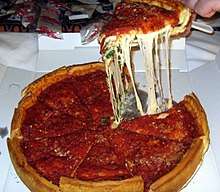

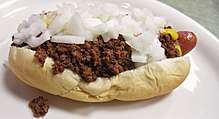
.jpg)